If you were expecting some kind of sun sign nonsense, forget about it. This is real astrology for the real world. If it's real astrology for yourself that you want, you can get it by phone or in print. And if you need help deciphering the astrological glyphs in the graphics accompanying this article, see Astroglyphs: Astrological Symbols Guide. Please note: this forecast is expressed in terms of Universal Time (UT).
Tomorrow will give us something to think about.
-- Cicereo
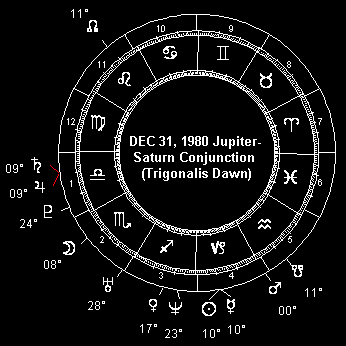 The big story for 2008, in a word, is money. It's much bigger than that, actually; but that's the headline. Money is an obvious and visible manifestation of the historic changes we're living through at the moment; it's also the foundation of our global civilization, and it's crumbling faster than most people might have imagined just a few years ago. This may sound at least politically incorrect, if not horribly crass and abysmally materialistic. But the simple fact is that money is a way of valuing what's important to humans, and without it there's no accountability, no responsibility - ultimately, only anarchy. And the money, in a word, is gone.
The big story for 2008, in a word, is money. It's much bigger than that, actually; but that's the headline. Money is an obvious and visible manifestation of the historic changes we're living through at the moment; it's also the foundation of our global civilization, and it's crumbling faster than most people might have imagined just a few years ago. This may sound at least politically incorrect, if not horribly crass and abysmally materialistic. But the simple fact is that money is a way of valuing what's important to humans, and without it there's no accountability, no responsibility - ultimately, only anarchy. And the money, in a word, is gone.
The headline for the year will be a global financial system in crisis, teetering at the precipice. It's a crisis that got going in a big way over the past two years, exactly as I predicted in my 2006 and 2007 forecasts. But the underlying story, the real deal, is that this is part of the ongoing and historic shift in civilization I've been writing about in my forecasts these past several years. It hit critical mass, as I have written, under the aegis of the 2006 Saturn-Jupiter-Neptune T-square configuration (the first of its kind since the year 536), and the subsequent 2006-2007 Saturn-Neptune opposition. These in turn are rooted in what the astrologers of old called the Trigonalis, the historic watershed we've all been living in since 1980-81 and which culminates in 2020. The Saturn-Uranus opposition and Neptune-lunar node conjunction of 2008 are the next steps along the way. These things need some explaining, and I'll get to that. But first . . .
Apocalyptic hysteria is spreading like wildfire, what with the "liquidity crisis" staring us in the face and the 2012 Mayan madness looming around the corner. I'm sure it sells books and glues eyeballs to the cable networks, but it's a lie. In the first place, the problem isn't a liquidity crisis per se. That's a euphemism, a way of avoiding the reality; which is that the global financial system is a charade, because what passes for money is in fact a sham. It's all very convenient to blame the liquidity crisis on those shiftless, sub-prime poor folks who conned unsuspecting lenders into issuing them mortgages for homes they couldn't afford. Or the crafty lenders who conned naïve borrowers into taking mortgages they couldn't afford. Or the greedy financiers who packaged up and unloaded those toxic mortgages onto banks and pension funds and hedge funds. The fact is that in a system of fiat money, where credit is created out of debt, the pursuit of ever-higher returns on investment is the only thing that keeps the whole system from crashing down. But there comes a time when that pursuit becomes unsustainable. We hit that wall in 2006-2007, as Saturn opposed Neptune in the heavens, just exactly as I predicted: "it's an alignment that points to a time when people, both individually and collectively, are experiencing a crisis of confidence. What was once apparently so solid and real that you could build a life, a financial system, a global trade network, even a civilization on it: that's just what has been dissolving under the aegis of Saturn's opposition to Neptune in combination with the T-square from Jupiter."
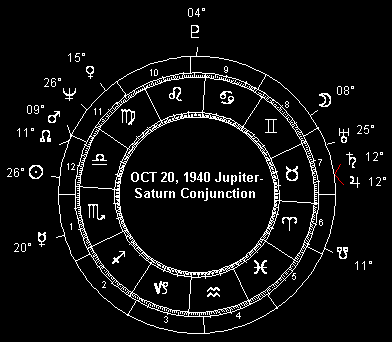 We're going to be dealing with the consequences of this turning point for some time to come . . . well past 2012 in fact, because the world won’t end then. Why would anyone believe a bunch of wacky Mayans silly enough to mistake Spaniards for gods, anyway? In short, this is not a time to despair, but to prepare. What to prepare for? Not just a monetary meltdown, although that's certainly part of it. Practically speaking, this means a continuing dollar collapse of course, but also a collapse of the yen, the pound, the euro - all the major currencies, because they're all essentially counterfeit. They aren't real money, in other words; they're only bank notes. The dollar may be up or down against the euro or pound this month or next; but in the long run, they'll all be down against gold, silver and the like until such time as the currencies once again are backed by real money. And that time is coming . . .
We're going to be dealing with the consequences of this turning point for some time to come . . . well past 2012 in fact, because the world won’t end then. Why would anyone believe a bunch of wacky Mayans silly enough to mistake Spaniards for gods, anyway? In short, this is not a time to despair, but to prepare. What to prepare for? Not just a monetary meltdown, although that's certainly part of it. Practically speaking, this means a continuing dollar collapse of course, but also a collapse of the yen, the pound, the euro - all the major currencies, because they're all essentially counterfeit. They aren't real money, in other words; they're only bank notes. The dollar may be up or down against the euro or pound this month or next; but in the long run, they'll all be down against gold, silver and the like until such time as the currencies once again are backed by real money. And that time is coming . . .
Ever since shortly after the Jupiter-Saturn conjunction of 1940-41, the entire world financial system has been dollar-based - and the dollar is broke, people. Not just the US Federal Reserve, but central banks all over the world - all of which have substantial dollar reserves - will eventually be forced to do what for several years I've recommended individuals do: buy gold (and other precious metals, but primarily gold). And for the same reason: the longer they hold dollars (or yen or euros or what-have-you), the less they're worth. (With Jupiter in Capricorn all year, the products of lands and mines and wells - and the producers of the equipment and providers of the services essential to that production - are where the real money is.)
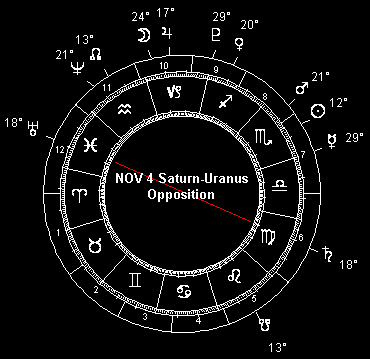 In the broader sense, what we're going through now are the death throes of one historical epoch, and the birth pangs of the next; the torch passing from one form of civilization to its successor. Is it any wonder that Saturn, whose Greek name (Chronos) is the root of chronology and all measures of time, is the celestial signal that marks off these shifts from one epoch to the next?
In the broader sense, what we're going through now are the death throes of one historical epoch, and the birth pangs of the next; the torch passing from one form of civilization to its successor. Is it any wonder that Saturn, whose Greek name (Chronos) is the root of chronology and all measures of time, is the celestial signal that marks off these shifts from one epoch to the next?
Speaking of the Ringed Planet, Saturn aligns in opposition to Uranus in 2008, for the first time in over forty years. The opposition of these two planets tends to come in sets of several, over a period of a couple years. The last set of Saturn-Uranus oppositions, for example, occurred in 1965-1967, and included five alignments in all. Two of these occurred with Saturn retrograde, and three with Uranus retrograde, all in the Virgo-Pisces polarity. The US Mint stopped producing silver coins around the time of this particular set of oppositions, and the US Treasury stopped redeeming Silver Certificates as well. Reality went out of monetary circulation because the US dollar had been sufficiently devalued that the silver in a silver dollar was worth more than a dollar. That's what Saturn-Uranus oppositions do: they replace a bankrupt regime with a new one, because the old fiction becomes too expensive to maintain.
The next set (2056-57) comprises only three Saturn-Uranus oppositions, and is relatively quick in passing. But this time around, the alignment of these two planets at opposite ends of the heavens stretches out from 2008 into 2010. The opposition is exact five times, from November 4, 2008 to July 26, 2010. Once again, this set includes two alignments with Saturn retrograde and Uranus direct, and three with Saturn direct and Uranus retrograde. The first four alignments are in the Virgo-Pisces polarity, like every other Saturn-Uranus opposition since August 13, 1919. And then things change: the July 26, 2010 alignment slides into the Aries-Libra polarity, where it will remain well into the next century. It's the first sign change for this opposition since the 1918-1920 set, which began in Leo-Aquarius in 1918 and slid into Virgo-Pisces in 1919. Saturn-Uranus oppositions won't change signs again until 2146.
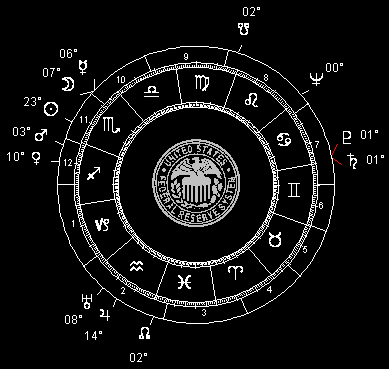 With the first polarity change in the Saturn-Uranus opposition since 1919 coming into play in the current sequence of oppositions between these two planets, the World-War I era - the League of Nations, the IRS, the Federal Reserve Bank - is finally coming to an end. So is the era of the Industrial Revolution, which historians date to the late 18th and early 19th Centuries - coinciding with the beginning of the current earth sign series of Jupiter-Saturn conjunctions. These were the two outermost planets known to the ancients, the two slowest moving wandering celestial orbs visible to the naked eye. Their conjunctions, when they appear to come together in the night sky, were the longest and therefore most historic planetary alignment cycles dealt with in ancient astrology. They remain a foundation for the astrological study of history, although the discovery of other more distant planets since the invention of the telescope provides astrologers with a great many more and longer-term cycles; e.g. the Saturn-Uranus and Saturn-Neptune cycles.
With the first polarity change in the Saturn-Uranus opposition since 1919 coming into play in the current sequence of oppositions between these two planets, the World-War I era - the League of Nations, the IRS, the Federal Reserve Bank - is finally coming to an end. So is the era of the Industrial Revolution, which historians date to the late 18th and early 19th Centuries - coinciding with the beginning of the current earth sign series of Jupiter-Saturn conjunctions. These were the two outermost planets known to the ancients, the two slowest moving wandering celestial orbs visible to the naked eye. Their conjunctions, when they appear to come together in the night sky, were the longest and therefore most historic planetary alignment cycles dealt with in ancient astrology. They remain a foundation for the astrological study of history, although the discovery of other more distant planets since the invention of the telescope provides astrologers with a great many more and longer-term cycles; e.g. the Saturn-Uranus and Saturn-Neptune cycles.
The alignment of Jupiter and Saturn at twenty-year intervals was known from ancient times as the Great Chronocrator, because it was observed to time significant turning points in civilization - indeed, entire eras, when the alignment changed element. (The change of element is termed the Trigonalis.) Until 1802, the Great Chronocrator had taken place in an unbroken series in the fire signs of the zodiac (Aries, Leo and Cancer), dating back to 1663. The shift into signs of the earth element began with the Virgo conjunction on July 17, 1802. This ushered in a period of transition that was interrupted by one final fire sign conjunction (in Aries, on Jun 19, 1821), before an unbroken series in the earth element began with the Capricorn conjunction of 1842.
The 1802-1842 period neatly brackets the beginning of the Industrial Revolution, although the precise dating of this turning point in civilization remains a subject of debate among historians. Simultaneously, modern capitalism ("finance capitalism") supplanted mercantilism as the prevailing economic system during this period, a transition first formalized de jure in Great Britain in the 1840s by the repeal of the Corn Laws and the Navigation Acts (in 1846 and 1849 respectively). The two went hand in hand: you can't have industrialism without expanding markets, and you can't have expanding markets without credit. Factories require banks, in other words. The Industrial Revolution was a Capital Revolution.
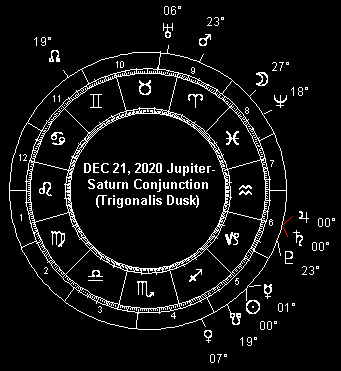 Fine points aside, it's clear that the transition from an economy (and more broadly, a civilization) based on manual labor to one based on mechanization (and the capitalist system required to fund it) roughly coincided with the beginning of the current earth sign series of the Great Chronocrator, which dates back to the period from 1802 (the earth sign alignment that broke the fire sign series) to 1842 (the beginning of an unbroken series of earth sign conjunctions). We may as well distinguish these Trigonalis periods as stretching from a dawn that coincides with the first out-of-element Chronocrator (the first one to break the old element series), to a dusk that coincides with the first in a long unbroken series in the new element. In that sense, we're now more than halfway from dawn to dusk in the current Trigonalis, the transition to a new order of the ages that will last for the better part of a couple centuries.
Fine points aside, it's clear that the transition from an economy (and more broadly, a civilization) based on manual labor to one based on mechanization (and the capitalist system required to fund it) roughly coincided with the beginning of the current earth sign series of the Great Chronocrator, which dates back to the period from 1802 (the earth sign alignment that broke the fire sign series) to 1842 (the beginning of an unbroken series of earth sign conjunctions). We may as well distinguish these Trigonalis periods as stretching from a dawn that coincides with the first out-of-element Chronocrator (the first one to break the old element series), to a dusk that coincides with the first in a long unbroken series in the new element. In that sense, we're now more than halfway from dawn to dusk in the current Trigonalis, the transition to a new order of the ages that will last for the better part of a couple centuries.
The earth sign Chronocrator series that ushered in industrialization and the civilization that embraced it is now itself in a period of transition into the next element series, which comprises the air signs (Gemini, Libra and Aquarius). The first air sign Chronocrator in centuries (since 1405, actually) happened in 1980-81, when a Libra triple conjunction broke into the earth sign run: the dawn of the new Trigonalis. However this was followed in 2000 by the last of the earth element series, the May 28 alignment at 22° 43' Taurus. The continuous air element Chronocrators begin in 2020, with the Jupiter-Saturn conjunction in Aquarius: the dusk of the current Trigonalis. The air sign series is then unbroken until 2159, when these two planets align in the water sign Scorpio. This ushers in the dawn of a new Trigonalis, which includes a return to the air element for the conjunctions of 2179 and 2199, before the continuous water element series begins in 2219 (carrying through to 2318).
The last earth to air Trigonalis occurred in 1166-1226, initiating a period of less than a century during which "there were more inventions developed and applied usefully than in the previous thousand years of human history." (See Wikipedia, "Renaissance of the 12th Century".) In retrospect, 1980 is just far enough back to seem historic from the perspective of today's culture of immediacy. That first air sign conjunction in centuries brought the popularization of the personal computer, followed shortly afterwards by the first generation cell phones: two developments very much in tune with the intellectual and communicative nature of the air element. (Arguably, both technologies had their antecedents; but their current manifestations are clearly recognizable in the wake of the 1980 Chronocrator.)
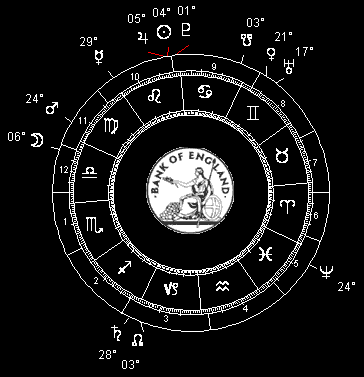 Connectivity is certainly a keyword of the promise held out by the air sign series, if its 1980 harbinger is any real indication. It's a peculiarly impersonal kind of connectivity, a virtual rather than real connection - and yet, it passes for real. People are in touch, but not touching. They're aware of so much, yet they fully grasp very little; they're smart, but not wise. The network is the thing. In short, the Chronocrator element change in 1980 heralded a fundamental shift in civilization, from earth (industrialization and finance capitalism) to air (virtualization, and a new economic order). Virtualization means globalization, and that's the one key outline of the new world order that's undeniably well underway. The earth sign Chronocrator series saw the rise of the modern nation-state, while the air sign series launched what is now glibly called globalization - which amounts to a dissolving of nation-states. Look around you, see the things that have grown up since 1980: the European Union, NAFTA, the dissolution of the Soviet Union and its emergence as an oligarchic capitalist entity, Red Capitalism in China, outsourcing, off-shoring, etc., etc.
Connectivity is certainly a keyword of the promise held out by the air sign series, if its 1980 harbinger is any real indication. It's a peculiarly impersonal kind of connectivity, a virtual rather than real connection - and yet, it passes for real. People are in touch, but not touching. They're aware of so much, yet they fully grasp very little; they're smart, but not wise. The network is the thing. In short, the Chronocrator element change in 1980 heralded a fundamental shift in civilization, from earth (industrialization and finance capitalism) to air (virtualization, and a new economic order). Virtualization means globalization, and that's the one key outline of the new world order that's undeniably well underway. The earth sign Chronocrator series saw the rise of the modern nation-state, while the air sign series launched what is now glibly called globalization - which amounts to a dissolving of nation-states. Look around you, see the things that have grown up since 1980: the European Union, NAFTA, the dissolution of the Soviet Union and its emergence as an oligarchic capitalist entity, Red Capitalism in China, outsourcing, off-shoring, etc., etc.
Judging from past Trigonalis periods, I think the one we're in now will lead to a new currency regime. This time, it will be global, and it won't be based on one particular national currency. The last Trigonalis, from 1802 to 1842, set the stage for the Bank of England going on the gold standard (per the 1844 Bank Charter Act). The 1940-1941 Jupiter-Saturn conjunction in Taurus was followed in short order by the Atlantic Charter, which set in motion the process that led to the 1944 Bretton Woods Agreement. In essence, Bretton Woods made the US dollar the money of the world. Which was all well in good as long as the dollar was backed by something real; namely gold. Unfortunately, the US stopped redeeming dollars in gold on August 15, 1971 - right in the middle of a triple Saturn-Neptune opposition, the last such alignment of these two planets prior to their 2006-2007 triple opposition. Since that time, the dollar is no longer real money, only bank notes, mere digits.
Neptune alignments have had a curious connection with historic financial developments, from the closing of the gold window in 1971 to the liquidity crisis of 2006-2007. There's another such Neptune alignment this year, to the Moon's north node. The lunar nodes are the points at which the plane of the Moon's orbit intersects the plane of Earth's orbit around the Sun (the ecliptic). Eclipses of the Sun and Moon occur because these two orbital planes cross, and when they do happen they always take place near the lunar nodes - within about 18° at most. There are two nodes, one for each point of intersection between the orbits of Earth and Moon. The north node is the point at which the Moon rises from below (south of) to above (north of) the ecliptic: it's the northward crossing, hence the name. Likewise, the south node is the Moon's southward crossing of the ecliptic. The Moon makes each crossing once a month in the course of its orbit around the Earth. When one of these crossings takes place at a time when Earth and Sun are aligned near enough the nodal degrees, an eclipse occurs: a lunar eclipse if there's a full moon, a solar eclipse if there's a new moon.
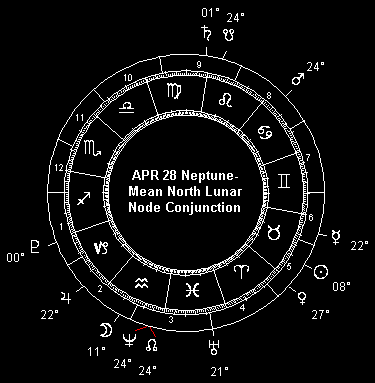 Eclipses are always important telltales of the cosmos in their own right, and I'll have more to say about the four eclipses of 2008 a little later. For now, those nodes where the eclipses happen are the focus, because they're involved in an unusual alignment this year. It's a factor that gives the year's eclipses a special importance and significance. This year, for the first time in 17 years, the Moon's north node will align in the same degree of the zodiac as the planet Neptune, at 24° Aquarius. It's the first conjunction in that sign since 1841 - the year of the first in a continuous series of earth sign Chronocrators, remember? - and the first in that very spot in the heavens (to the nearest degree) since 1189 (during the last earth-to-air Trigonalis, remember?).
Eclipses are always important telltales of the cosmos in their own right, and I'll have more to say about the four eclipses of 2008 a little later. For now, those nodes where the eclipses happen are the focus, because they're involved in an unusual alignment this year. It's a factor that gives the year's eclipses a special importance and significance. This year, for the first time in 17 years, the Moon's north node will align in the same degree of the zodiac as the planet Neptune, at 24° Aquarius. It's the first conjunction in that sign since 1841 - the year of the first in a continuous series of earth sign Chronocrators, remember? - and the first in that very spot in the heavens (to the nearest degree) since 1189 (during the last earth-to-air Trigonalis, remember?).
Any planet that's on or fairly near the nodal axis - as Neptune is in 2008 - is bound to be aligned with an eclipse. That makes planetary conjunctions and oppositions to the lunar nodes a signal that eclipses taking place around the time of these planetary-nodal alignments will be colored by the nature of the planet in the alignment. Any eclipse represents an emphasis on things signified by the Sun, Earth and Moon - the three bodies in the eclipse. Of course this means geophysical phenomena, such as storms and seismic disturbances. But these three are the substrata of all human experience, from gender to food to territory and power. Last year, the eclipses took place in Virgo-Pisces, with Saturn in Virgo opposing the Moon's north node. (The lunar eclipse of August 28 was directly opposite Saturn.) It was, generally speaking, a year - and it really hit home in August - that was all about Saturn: debts coming due, people coming up short, money and security vanishing, hard times particularly with regard to health care and foodstuffs, etc.
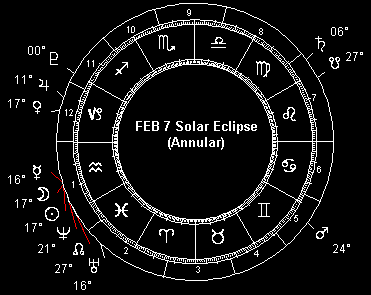 With Neptune on the north lunar node in 2008, this year's eclipses are Neptunian in nature as they slide from the Virgo-Pisces polarity into Leo-Aquarius. February and August are the months to watch. The solar eclipse on February 7 is conjunct Neptune, as is the lunar eclipse on August 16. This in effect extends the 2006-2007 Saturn-Neptune opposition theme: a loss of confidence, the money's gone, misplaced faith, theft and deception (including self-deception), the Emperor has no clothes. This operates at a lot of levels, to be sure. But given what has already gone before, and the fact that we're having a Saturn-Uranus opposition this year as well, I have to think the currency crisis now underway gets a whole lot bigger in 2008. And the Saturn-Uranus opposition speaks of international conferences addressing what has become a global financial crisis.
With Neptune on the north lunar node in 2008, this year's eclipses are Neptunian in nature as they slide from the Virgo-Pisces polarity into Leo-Aquarius. February and August are the months to watch. The solar eclipse on February 7 is conjunct Neptune, as is the lunar eclipse on August 16. This in effect extends the 2006-2007 Saturn-Neptune opposition theme: a loss of confidence, the money's gone, misplaced faith, theft and deception (including self-deception), the Emperor has no clothes. This operates at a lot of levels, to be sure. But given what has already gone before, and the fact that we're having a Saturn-Uranus opposition this year as well, I have to think the currency crisis now underway gets a whole lot bigger in 2008. And the Saturn-Uranus opposition speaks of international conferences addressing what has become a global financial crisis.
I don't see a solution this year, mind you. Saturn and Uranus make their on-and-off opposition last until 2010, after all. The fix begins in 2008, probably after the US Presidential election, but it takes years until the fix is in. That's because just about everybody's ox is going to get gored, before this is done. And since the fix has always been and will ever be a hard money foundation underlying paper currency, you can expect that the international experts will ultimately agree on things like gold, silver, platinum and the like being basic to whatever solution arises. Other commodities will be argued for and accepted to some degree (oil, uranium, silicon chips, photovoltaic cells, etc.), but the foundation will be the precious metals because they are in fact a store of value: always have been, always will be. And, incidentally, an essential part of this restoration entails the price of precious metals skyrocketing in the process of liquidating debt. If that doesn't tell you what to do, you haven't been paying attention . . .
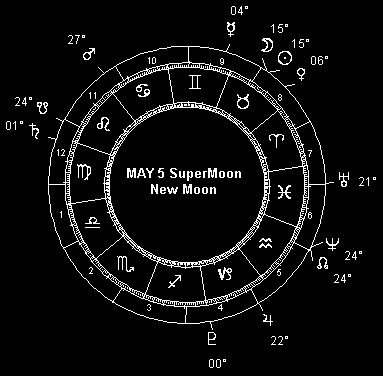 I mentioned Neptune's connection with the eclipses of 2008, and certainly these alignments will bring times of particular social, economic and political significance. But eclipses - and SuperMoons as well - are also notable in their own right, as indicators of geophysical surges affecting everything on Earth.
I mentioned Neptune's connection with the eclipses of 2008, and certainly these alignments will bring times of particular social, economic and political significance. But eclipses - and SuperMoons as well - are also notable in their own right, as indicators of geophysical surges affecting everything on Earth.
SuperMoon is a term I coined in a 1979 article for Dell Publishing Company's HOROSCOPE magazine, describing what is technically called a perigee-syzygy; a new or full moon (syzygy) which occurs with the Moon at or near (within 90% of) its closest approach to Earth in a given orbit. In short, Earth, Moon and Sun are all in a line, with Moon in its nearest approach to Earth. (My most recent print article on this subject appeared in the October-November 2007 issue of The Mountain Astrologer.)
Like eclipses, there are typically four or five SuperMoons each year. We get five this year. These include a trio of new moons in the spring: one on May 5 (15° 22' Taurus), followed by another on June 3 at 13° 34' Gemini, and a third on July 3 at 11° 32' Cancer. A pair follows in the fall, both full moons: one on November 13 at 21° 15' Taurus, and the second on December 12 at 21° 2' Gemini.
SuperMoons are noteworthy for their close association with extreme tidal forces working in what astrologers of old used to call the sublunary world; which is to say, in the atmosphere, crust and oceans of our home planet - including ourselves, of course. From extreme coastal tides to severe storms to powerful earthquakes and volcanic eruptions, the entire natural world surges and spasms under the sway of the SuperMoon alignment - within three days either way of the exact syzygy, is the rule of thumb.
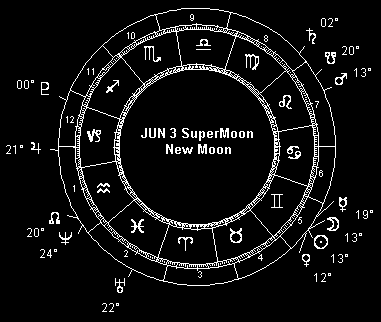 If you're interested in the history of SuperMoon alignments in connection with great storms, earthquakes and volcanic eruptions, you'll find a sampling of them in my book Interpreting Astrology (published by the American Federation of Astrologers). But a simple review of the news over the past few years should serve to get you acquainted. Take Hurricane Katrina, for example; spawned from a tropical depression formed within three days of the August 19 SuperMoon. My forecast for 2005 warned of severe storms within plus or minus three days of the day Hurricane Katrina formed, and even specified the Gulf of Mexico as one of the areas at risk in connection with that particular SuperMoon alignment. I've done this for some thirty years now, from articles in the astrology press to the online forecasts at my website, Astropro.
If you're interested in the history of SuperMoon alignments in connection with great storms, earthquakes and volcanic eruptions, you'll find a sampling of them in my book Interpreting Astrology (published by the American Federation of Astrologers). But a simple review of the news over the past few years should serve to get you acquainted. Take Hurricane Katrina, for example; spawned from a tropical depression formed within three days of the August 19 SuperMoon. My forecast for 2005 warned of severe storms within plus or minus three days of the day Hurricane Katrina formed, and even specified the Gulf of Mexico as one of the areas at risk in connection with that particular SuperMoon alignment. I've done this for some thirty years now, from articles in the astrology press to the online forecasts at my website, Astropro.
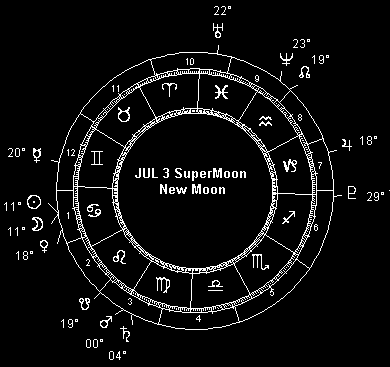 Examples of the SuperMoon connection with major storms and seismic events abound: the Mt. Pinatubo eruption, the largest volcanic event in the second half of the 20th Century, took place on June 15, 1991 (within three days of a SuperMoon); the October 6, 1948 Richter 7.3 earthquake that struck Ashgabat, Turkmenistan and took 110,000 lives, one of the deadliest earthquakes on record (again within three days of a SuperMoon, allowing for time zones); and the September 8, 1900 hurricane and tidal surge that struck Galveston, Texas on the day of a SuperMoon, which killed more people (8,000 dead) than any other Atlantic hurricane on record and remains the deadliest natural disaster yet to strike the United States. I'm just scratching the surface here, citing only a few of the most historic instances in the past hundred years or so. Look a little deeper, and you'll run across literally hundreds more greater and lesser seismic and meteorological disturbances, from Hurricane Andrew in 1992 to the 1989 World Series (Loma Prieta) earthquake - just to name a couple recent examples.
Examples of the SuperMoon connection with major storms and seismic events abound: the Mt. Pinatubo eruption, the largest volcanic event in the second half of the 20th Century, took place on June 15, 1991 (within three days of a SuperMoon); the October 6, 1948 Richter 7.3 earthquake that struck Ashgabat, Turkmenistan and took 110,000 lives, one of the deadliest earthquakes on record (again within three days of a SuperMoon, allowing for time zones); and the September 8, 1900 hurricane and tidal surge that struck Galveston, Texas on the day of a SuperMoon, which killed more people (8,000 dead) than any other Atlantic hurricane on record and remains the deadliest natural disaster yet to strike the United States. I'm just scratching the surface here, citing only a few of the most historic instances in the past hundred years or so. Look a little deeper, and you'll run across literally hundreds more greater and lesser seismic and meteorological disturbances, from Hurricane Andrew in 1992 to the 1989 World Series (Loma Prieta) earthquake - just to name a couple recent examples.
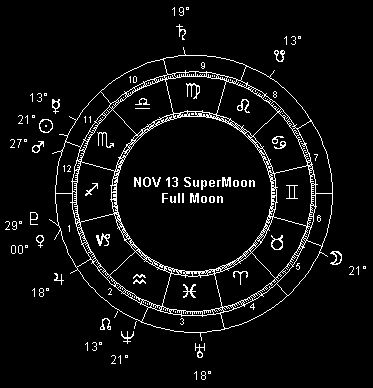 Obviously it won't be the case that all hell will break loose all over the world within a few days either side of the SuperMoons of 2008 - or the similarly potent eclipses either, which I'll cover in a moment. For most of us, the geocosmic risk raised by SuperMoon alignments will pass with little notice in our immediate vicinity. But the fact remains that a SuperMoon is planetary in scale, being a special alignment of Earth, Sun and Moon. It's likewise planetary in scope, in the sense that there's no place on Earth not subject to the tidal force of the perigee-syzygy. Of course, earthquakes and volcanic eruptions don't go wandering all over the planet. They happen in predictable locations, like the infamous "Ring of Fire" around the Pacific plate. If you're in (or plan to be in) a place that's subject to seismic upheaval during a SuperMoon stress window, it's not hard to figure out that being prepared to the extent that you can is not a bad idea. Likewise, people on the coast should be prepared for extreme tidal surges. Severe storms on the other hand can strike just about anywhere, so it behooves us all to be ready for rough weather when a SuperMoon alignment forms.
Obviously it won't be the case that all hell will break loose all over the world within a few days either side of the SuperMoons of 2008 - or the similarly potent eclipses either, which I'll cover in a moment. For most of us, the geocosmic risk raised by SuperMoon alignments will pass with little notice in our immediate vicinity. But the fact remains that a SuperMoon is planetary in scale, being a special alignment of Earth, Sun and Moon. It's likewise planetary in scope, in the sense that there's no place on Earth not subject to the tidal force of the perigee-syzygy. Of course, earthquakes and volcanic eruptions don't go wandering all over the planet. They happen in predictable locations, like the infamous "Ring of Fire" around the Pacific plate. If you're in (or plan to be in) a place that's subject to seismic upheaval during a SuperMoon stress window, it's not hard to figure out that being prepared to the extent that you can is not a bad idea. Likewise, people on the coast should be prepared for extreme tidal surges. Severe storms on the other hand can strike just about anywhere, so it behooves us all to be ready for rough weather when a SuperMoon alignment forms.
That said, there's no harm in making sensible preparations for the SuperMoons of 2008. What's the worst that can happen, if the worst doesn't happen? Where's the harm in having a few extra fresh batteries and candles, some extra bottled water and canned goods, maybe a full tank of gas and an evacuation bag packed just in case? And maybe you'll think twice about being in transit and more than usually vulnerable to the vagaries of weather hazards and delays. These may amount to only minor inconveniences. But they're the kind of sensible precautions that can make a big difference if the worst does come to pass. I can only call the dates. You have to make the decision, and take the action, to be prepared or not.
Their planetary scope notwithstanding, astro-mapping may offer some hints as to areas of special vulnerability for each individual SuperMoon alignment. The May 5 SuperMoon, for example, shows astro-locality links along a longitudinal line that sweeps from the British Isles down through western Europe and west Africa in the western hemisphere, and across New Zealand in the east. A horizon arc from this SuperMoon sweeps through Alaska and the western US and Canada, down through Mexico and across the southern tip of South America, coming up eastern India into China, Mongolia and Siberia. I'm also seeing some rather threatening looking Mars lines sweeping from Anchorage across to Edmonton and down through New Orleans and Buenos Aires, across open ocean to southeastern Australia.
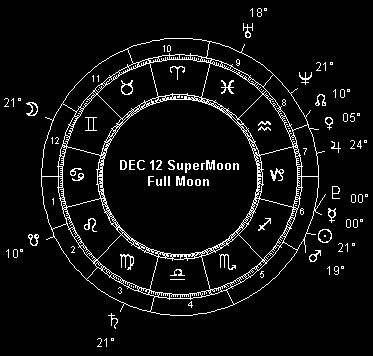 The Rocky Mountain range from Canada clean through the US and down through the Baja is one of the longitudinal risk ribbons associated with the June 3 SuperMoon. This same line emerges on the other side of the world to cross India, Pakistan and Russia. The horizon arc for this SuperMoon skirts the west coast of Africa to pass through western Europe, crossing northern Russia and China to pass through Japan on its way down to New Zealand. A sweeping Mars arc has an ominous look to it at this SuperMoon, and it stretches from the Aleutians to just east of Hawaii to emerge just off the southeast coast of Africa before jutting up through the Middle East and out through Siberia. I figure the June 3 SuperMoon to be one of the strongest storm and seismic indicators of the year, falling within hours of lunar perigee and the Moon's north declination extreme for the month.
The Rocky Mountain range from Canada clean through the US and down through the Baja is one of the longitudinal risk ribbons associated with the June 3 SuperMoon. This same line emerges on the other side of the world to cross India, Pakistan and Russia. The horizon arc for this SuperMoon skirts the west coast of Africa to pass through western Europe, crossing northern Russia and China to pass through Japan on its way down to New Zealand. A sweeping Mars arc has an ominous look to it at this SuperMoon, and it stretches from the Aleutians to just east of Hawaii to emerge just off the southeast coast of Africa before jutting up through the Middle East and out through Siberia. I figure the June 3 SuperMoon to be one of the strongest storm and seismic indicators of the year, falling within hours of lunar perigee and the Moon's north declination extreme for the month.
Another especially potent looking SuperMoon is the July 3 alignment, which is close on the heels of the Moon reaching both perigee and peak declination north of the celestial equator on the 1st. Any SuperMoon ups the risk of severe storms and moderate to severe seismic outbursts, but this one appears to be "more equal than others". Eastern Brazil and Greenland fall under the western end of a longitudinal risk zone associated with the July 3 SuperMoon. The eastern end of that same line runs east of Japan down through New Guinea and eastern Australia. The horizon arc for this SuperMoon sweeps across northern Mexico northeasterly through the northern Plains into eastern Canada, across northern Europe and down through the Middle East. The Aleutians and Hawaii fall in a longitudinal Mars-Saturn risk zone associated with this SuperMoon, while those same two planets are on a horizon arc that cuts across northwestern South America, out into the Caribbean and the Atlantic, across southern Greenland and down through central Asia and Indochina to cross Indonesia and western Australia.
The November 13 SuperMoon is another one of the more potent than usual variety, judging from its close proximity to the lunar perigee on the 14th and peak lunar declination on the 15th, as well as its near-alignment with Mars (not to mention a T-square to Neptune). Central America, Mexico, the Gulf of Mexico, the Plains States, the Mississippi River Valley and central Canada fall in a longitudinal elevated risk zone for this alignment; the same zone emerges on the other side of the planet to cut through India, Bangladesh, Nepal, China, Mongolia and Russia. The horizon arcs for this alignment are mostly over open ocean in the New World, but they do cut across west Africa and eastern Europe, curving across Russian (near Moscow) to emerge over northern Japan.
 December 12 brings the last SuperMoon of the year. On paper at least, it looks like the most ominous of the bunch. It happens to be the Moon's closest perigee of the year, and occurs within just a couple hours of the month's peak lunar north declination. On top of that, Mars is within two degrees of exactly opposite this particular full moon, which happens to make a Grand Cross pattern when the Saturn-Uranus opposition is figured in. This looks like some pretty expensive storm, flood and/or seismic damage potential, to me. As always, there's no place on Earth beyond the reach of one or more such natural upheavals during any SuperMoon alignment. But astro-locality mapping does point out some zones that appear to be especially vulnerable. In this case there's a longitudinal risk sector from New York down through Hispaniola and on to Santiago in the New World, which emerges to cross from Siberia down through Mongolia and central China down through Indochina, Singapore and Indonesia. The especially ominous-looing horizon arc goes from Hawaii to British Columbia, across northern Canada and the southern tip of Greenland to cross the Atlantic and then swing through Iberia across the Mediterranean and diagonally from northwest to southeast Africa, and finally through New Zealand from one end to the other.
December 12 brings the last SuperMoon of the year. On paper at least, it looks like the most ominous of the bunch. It happens to be the Moon's closest perigee of the year, and occurs within just a couple hours of the month's peak lunar north declination. On top of that, Mars is within two degrees of exactly opposite this particular full moon, which happens to make a Grand Cross pattern when the Saturn-Uranus opposition is figured in. This looks like some pretty expensive storm, flood and/or seismic damage potential, to me. As always, there's no place on Earth beyond the reach of one or more such natural upheavals during any SuperMoon alignment. But astro-locality mapping does point out some zones that appear to be especially vulnerable. In this case there's a longitudinal risk sector from New York down through Hispaniola and on to Santiago in the New World, which emerges to cross from Siberia down through Mongolia and central China down through Indochina, Singapore and Indonesia. The especially ominous-looing horizon arc goes from Hawaii to British Columbia, across northern Canada and the southern tip of Greenland to cross the Atlantic and then swing through Iberia across the Mediterranean and diagonally from northwest to southeast Africa, and finally through New Zealand from one end to the other.
Like SuperMoons, eclipses are important indicators of major geophysical stress. Tradition from ancient times associates eclipses with natural disasters. The Greek historian Thucydides (5th Century BCE) wrote about "an eclipse of the Sun at the time of a new moon, and in the early part of the same month an earthquake." In the 2nd Century CE his countryman Phlegon reported that "in the fourth year of the 202nd Olympiad, there was an eclipse of the Sun . . . and a great earthquake that broke out in Bithynia destroyed the greatest part of Nicaea."
The association of seismic upheaval and other natural calamities with eclipses isn't solely a preoccupation of ancient historians. It survives to this day, because powerful earthquakes, notable volcanic eruptions and great storms persist in their synchronicity with eclipses. Examples closer to our own time include the May 8, 1902 eruption of Mt. Pelee, which left 29,000 dead and destroyed the city of St. Pierre in the West Indies - within a day of a SuperMoon that also happened to be a partial solar eclipse.
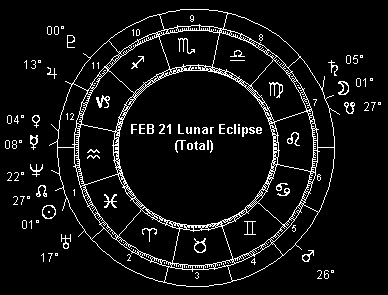 My own rule of thumb for eclipses is that solar eclipses have a geophysical shock window that extends a week either side of the exact date, while lunar eclipses are effective within a plus or minus three day window. If the seven day-either way window for solar eclipses seems extravagant, consider that it represents an orb (allowance or tolerance) of only seven degrees for the Sun; and that eclipses can happen when the Sun and Moon align within as much as 18 degrees either side of the lunar nodes. When you consider that it's less than half the effective orb between the lunar nodes and a new moon eclipse, seven degrees might not look so large after all.
My own rule of thumb for eclipses is that solar eclipses have a geophysical shock window that extends a week either side of the exact date, while lunar eclipses are effective within a plus or minus three day window. If the seven day-either way window for solar eclipses seems extravagant, consider that it represents an orb (allowance or tolerance) of only seven degrees for the Sun; and that eclipses can happen when the Sun and Moon align within as much as 18 degrees either side of the lunar nodes. When you consider that it's less than half the effective orb between the lunar nodes and a new moon eclipse, seven degrees might not look so large after all.
The eclipses of 2008 start out with the annular solar eclipse on February 7 at 17° 44' Aquarius, conjunct Mercury and Neptune. It's the 60th solar eclipse in Saros Series 121, which began with the partial solar eclipse of April 25, 944 - at a time when Saturn and Uranus were aligned in the sky (conjunct, rather than opposed as they are in 2008). That's not the only eclipse connection to Saturn and Uranus this month . . .
Visible over Antarctica, New Zealand and parts of Australia, the eclipse is likely to coincide with some notable geophysical disturbances in this region during the January 31-February 14 risk window - most likely around the 2nd, 7th, 9th and 14th in particular. Astro-locality mapping paints a couple of longitudinal risk zones crossing Australia, Indonesia, Japan and China in the eastern hemisphere, and from Venezuela through Brazil down into Argentina in the west. There's also a special vulnerability horizon sweeping from the Aleutians to east of Hawaii, along east Africa into the Middle East and through Russia. While these appear to be zones of particular susceptibility, no place on Earth is ever beyond the reach of severe weather, so be prepared regardless of where you happen to be during the January 31-February 14 risk window.
This eclipse will be more than a storm and seismic marker, incidentally. It looks like a market mover as well, under the impetus of breaking news that gives the lie to past assurances that credit and liquidity problems are under control. Bigger debts, weaker economic data, liar loans, money scandals, credit cover-ups and freeze-ups . . . and even then the official explanations are delusional. Anyone with anything important in their natal chart around 18° of the fixed signs (Taurus, Leo, Scorpio and Aquarius - especially Aquarius/Leo) might want to pay particular attention to this eclipse.
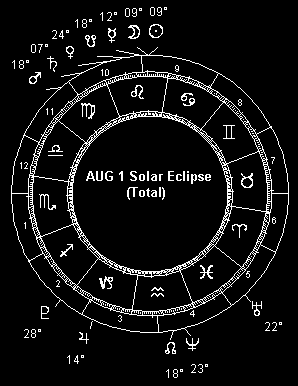 Then comes the February 21 total lunar eclipse at 1° 53' Virgo, visible from start to finish over most of the western hemisphere. Conjunct Saturn, this eclipse signals a time of worries. Of course, given the rest of what's happening this month and throughout 2008, there will be millions of people worried about their jobs, their homes, the food on their tables; but also sickness and the means to remedy it. This will be the 26th lunar eclipse in Saros Cycle 133, which began with the partial lunar eclipse of May 13, 1557. Look it up in my table of Saturn-Uranus oppositions: the signature alignment of 2008 was there at the birth of Saros 133 too, back in 1557. It was the year of an influenza epidemic in Europe, as well as a great financial crisis. Another Saros 133 lunar eclipse, another Saturn-Uranus opposition . . . another financial crisis, certainly. An epidemic too? Not so certain . . . but if you haven't already had your flu shot, time's a wastin'.
Then comes the February 21 total lunar eclipse at 1° 53' Virgo, visible from start to finish over most of the western hemisphere. Conjunct Saturn, this eclipse signals a time of worries. Of course, given the rest of what's happening this month and throughout 2008, there will be millions of people worried about their jobs, their homes, the food on their tables; but also sickness and the means to remedy it. This will be the 26th lunar eclipse in Saros Cycle 133, which began with the partial lunar eclipse of May 13, 1557. Look it up in my table of Saturn-Uranus oppositions: the signature alignment of 2008 was there at the birth of Saros 133 too, back in 1557. It was the year of an influenza epidemic in Europe, as well as a great financial crisis. Another Saros 133 lunar eclipse, another Saturn-Uranus opposition . . . another financial crisis, certainly. An epidemic too? Not so certain . . . but if you haven't already had your flu shot, time's a wastin'.
In addition to its zone of visibility - pretty much the whole western world - the February 21 lunar eclipse raises the storm and seismic risk level worldwide. This alignment is planetary in scale, after all. Astro-locality maps out a familiar danger zone for this eclipse; pretty much identical to the solar eclipse earlier in the month: a couple of longitudinal special risk zones crossing Australia, Indonesia, Japan and China in the eastern hemisphere, and from Venezuela through Brazil down into Argentina in the west, along with a special vulnerability horizon sweeping from the Aleutians to east of Hawaii, along east Africa into the Middle East and through Russia. I don't recall seeing a one-two punch like this, in decades of looking at astro-locality eclipse maps. It will be fascinating to see what develops. Probably more fascinating if you've got fresh batteries and plenty of bottled water ready at hand.
The August 1 total solar eclipse at 9° 32 Leo lies in the middle of a geophysical stress window that stretches from July 25 to August 8 (probably peaking around July 29 as well as August 1 and 4). Northeastern North America and most of Europe and Asia fall under the shadow of the eclipse, and that makes them obvious targets of the increased storm and seismic potential at work during this period. Astro-locality mapping picks up a few other possible danger zones, including a longitudinal swath through Alaska and Hawaii in the New World, and from Johannesburg up through St. Petersburg in the Old; as well as a horizon arc that sweeps across Alaska and northwest Canada down through the Great Lakes to pass over Washington DC into the Atlantic, across Hispaniola and passing over Caracas through southern Brazil. In the eastern hemisphere, this arc passes over Indonesia and the Philippines to skirt western Japan, the Korean Peninsula and Vladivostok.
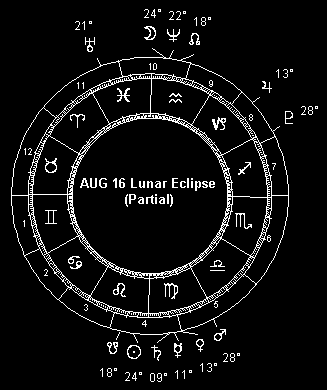 The last eclipse of the year is the partial lunar eclipse at 24° 21' Aquarius on August 16. It's number 29 in Saros Series 138, which began in 1503 (the year of Nostradamus' birth). The elevated storm and seismic risk associated with this eclipse extends from the 13th through the 19th, and appears to be most intense around the 16th and 19th in particular. Such risks, as always, are planet-wide. However they may be most pronounced in areas where the eclipse is visible (mainly the eastern hemisphere, although eastern South America catches a glimpse), as well as along certain astro-locality zones. These include longitudinal swaths running through the Yukon in the New World and through Russia, the Middle East and East Africa in the Old; also along horizon arcs that sweep from Buenos Aires through Iceland and down through Mongolia and China, Indonesia and Australia. Economic issues are likely to be a major concern in the world around the time of this eclipse, which is conjunct Neptune at a time when there's a triple conjunction of Mercury, Venus and Saturn going on.
The last eclipse of the year is the partial lunar eclipse at 24° 21' Aquarius on August 16. It's number 29 in Saros Series 138, which began in 1503 (the year of Nostradamus' birth). The elevated storm and seismic risk associated with this eclipse extends from the 13th through the 19th, and appears to be most intense around the 16th and 19th in particular. Such risks, as always, are planet-wide. However they may be most pronounced in areas where the eclipse is visible (mainly the eastern hemisphere, although eastern South America catches a glimpse), as well as along certain astro-locality zones. These include longitudinal swaths running through the Yukon in the New World and through Russia, the Middle East and East Africa in the Old; also along horizon arcs that sweep from Buenos Aires through Iceland and down through Mongolia and China, Indonesia and Australia. Economic issues are likely to be a major concern in the world around the time of this eclipse, which is conjunct Neptune at a time when there's a triple conjunction of Mercury, Venus and Saturn going on.
SuperMoons and eclipses are not the only celestial phenomena to turn up every year. Another familiar annual theme involves the cycles of Mercury. Being closest to the Sun, Mercury goes intersolar as seen from Earth more than any other planet; several times a year in fact, including the infamous Mercury retrogrades of astrological legend. While most astrologers pay a fair amount of attention to Mercury's retrograde, few realize that it's only a part of the more fundamental intersolar phase in the orbital interaction between Mercury and Earth, as they both orbit around the Sun.
Mercury's intersolar phase begins when the little Sun-grazer reaches its maximum elongation east of the Sun - its evening star phase. This happens when Mercury has come 'round to the same side of the Sun as Planet Earth, and is relatively near us. The little planet is then pulling up to pass Earth on the inside track, as it were; catching up to us from behind and then passing between us and the Sun. Just as it catches up with us, Mercury passes directly between Earth and the Sun. This is Mercury's inferior conjunction with the Sun. After the inferior conjunction, Mercury continues pulling ahead of us until it reaches its greatest elongation west of the Sun (its morning star phase), at which point the little planet is headed toward the far side of our parent star. Between these two extremes, the greatest east and west elongations, comes the fabled Mercury retrograde period of astrological lore.
Retrograde means moving backwards. This is what Mercury appears to do in our skies when the little inner planet catches up on us and passes us on the inside, between Earth and the Sun. First Mercury reaches its greatest eastern elongation, then it appears to stand still in the sky (the retrograde station), and then it appears to move backwards through the heavens for a period of several weeks: that's Mercury retrograde for you. It ends when the little Sun-grazer's backwards motion comes to an apparent halt (the direct station); after which, Mercury moves forward again, until it reaches its maximum elongation west of the Sun. The reality of course is that Mercury never stops in its orbit, and never moves backward: this is only how the relative motions of Earth and Mercury around the Sun cause Mercury to move through our night sky.
 Mercury retrograde is the cycle when everything goes wrong, to hear some astrologers tell it. The truth is not so simple-minded. All things Mercurial are crucial during the intersolar Mercury phase; infrastructure, commerce, information, communication and transport being prime examples. Absent careful investigation and planning, and conscientious follow-through, all such things are apt to go off track during these cycles. There is "a time to every purpose under heaven," as the Preacher wrote (Ecclesiastes 3:1). Mercury's intersolar phase is a time for focus, concentration, planning, follow-through and communication - all the qualities of the active and involved mind, in short. In case you haven't noticed, most people are not especially alert and focused most of the time. When this kind of sleepwalking runs into Mercury's intersolar cycle, with its focus on mental acuity, it doesn't take long for things to go awry. If you're sharp and focused and alert, you can avoid a certain amount of this mess. In fact, you can even prosper by concentrating on tasks that center on thought, planning and communication. But you'll still have to dodge all the chaos created by the people who are sleepwalking. So be ready.
Mercury retrograde is the cycle when everything goes wrong, to hear some astrologers tell it. The truth is not so simple-minded. All things Mercurial are crucial during the intersolar Mercury phase; infrastructure, commerce, information, communication and transport being prime examples. Absent careful investigation and planning, and conscientious follow-through, all such things are apt to go off track during these cycles. There is "a time to every purpose under heaven," as the Preacher wrote (Ecclesiastes 3:1). Mercury's intersolar phase is a time for focus, concentration, planning, follow-through and communication - all the qualities of the active and involved mind, in short. In case you haven't noticed, most people are not especially alert and focused most of the time. When this kind of sleepwalking runs into Mercury's intersolar cycle, with its focus on mental acuity, it doesn't take long for things to go awry. If you're sharp and focused and alert, you can avoid a certain amount of this mess. In fact, you can even prosper by concentrating on tasks that center on thought, planning and communication. But you'll still have to dodge all the chaos created by the people who are sleepwalking. So be ready.
Among the sort of things to be ready for during the above mentioned Mercury intersolar cycles: strikes and other disruptions affecting transportation and communication (e.g. postal, phone, mass transit, trucking, airline, shipping, dock and warehouse workers, teachers and all manner of media). Weather both terrestrial and solar (including geomagnetic storms) can play a part in the kind of breakdowns described here, but human effort (and sometimes malicious action) is a part of the mix as well. Power failures due to infrastructure breakdown and computer network disruptions caused by hacker attacks, software vulnerabilities and the like are also just a crossed wire or a keystroke away from a major mess at these times.
If I had to pick a day to have a backup generator all fueled up and ready to go, a contingency plan in place in case the scheduled or expected didn't come to pass, a day to be especially sharp and steady and focused - it would be during one of these Mercury cycles. Note these dates; be ready with a fallback plan just in case. It's not so much that disaster is destined to strike when Mercury is in its intersolar phase. Rather, it's that everything pertaining to Mercury becomes crucial; and unless it's treated as such, then it goes awry. More and more, we live in a "just in time" world - and if the slightest delay holds up just one single thing, then a whole process screeches to a halt. Unfortunately, few people keep their eye on the ball with any consistency and diligence. And that's the reason these Mercury cycles tend to turn into Murphy's Law festivals. Don't say I didn't warn you!
 The first intersolar Mercury phase of 2008 begins with the little planet's maximum elongation eastward on January 22, includes the January 28-February 19 retrograde and the February 6 inferior conjunction with the Sun, and ends with Mercury's greatest western elongation on March 3. Next comes the May 14 greatest eastern elongation, initiating a Mercury intersolar cycle which includes the May 26-June 19 retrograde and the June 7 inferior conjunction, and concludes with the July 1 western elongation maximum. Finally this year there's the Mercury intersolar phase that starts with the maximum eastern elongation on September 11, includes the September 24-October 15 retrograde and the October 6 inferior conjunction, and wraps up with the western elongation extreme on October 22.
The first intersolar Mercury phase of 2008 begins with the little planet's maximum elongation eastward on January 22, includes the January 28-February 19 retrograde and the February 6 inferior conjunction with the Sun, and ends with Mercury's greatest western elongation on March 3. Next comes the May 14 greatest eastern elongation, initiating a Mercury intersolar cycle which includes the May 26-June 19 retrograde and the June 7 inferior conjunction, and concludes with the July 1 western elongation maximum. Finally this year there's the Mercury intersolar phase that starts with the maximum eastern elongation on September 11, includes the September 24-October 15 retrograde and the October 6 inferior conjunction, and wraps up with the western elongation extreme on October 22.
Mars is retrograde this year as well, having reversed its apparent course in the sky in November 2007. The Red Planet's retrograde cycle ends on January 30, and Mars is finally up to speed again by early April. Mars cycles of this sort happen only once every couple years or so. They're not unlike the intersolar cycles of Mercury and Venus, in that they emphasize the nature of the planet in question during that portion of its orbit where it passes closest to Earth. But unlike Mercury and Venus, Mars orbits outside our home planet's path. Technicalities aside, the high Mars cycle runs from roughly the waxing to the waning square (90d angle) of the Sun to Mars; i.e., from the time the Sun moves up to about 90 degrees ahead of Mars to when it moves to about 90 degrees behind Mars. So the high Mars cycle that began in September 2007 will conclude in April 2008. While it continues, we remain in a period of elevated tension and conflict, the kind of atmosphere that cultivates inflamed passions, hot tempers and rash, even violent action - of the criminal and military type, even. (Look at the Turkish attacks on northern Iraq, the assassination of Benazir Bhutto in Pakistan, etc.) Apart from the direct impact of the fires, clashes, crashes and explosions that are par for the course under this sort of Mars close pass, some such incidents can raise the possibility of a disruption in the oil and natural gas supply chain - which in turn can shock the financial markets and put investors and institutions in a mad dash for the exits.
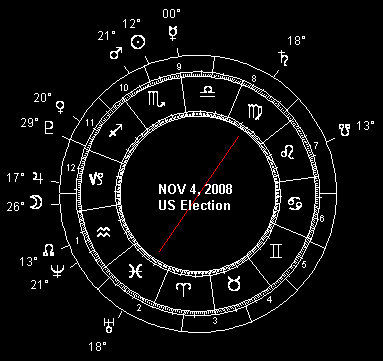 Criminality, terrorism, military conflict: these things are always with us, even if they are especially prominent during Mars cycles like the one that continues into April 2008. But there's no need to panic. This isn't the end of the world. These bloody Mars cycles come up every couple of years, so we've survived plenty of them to date. Just be aware of the heightened potential for violence, irritability, haste and conflict, and act accordingly. In particular, the period around the Mars direct station (January 30) is one peak point in this kind of potential. However there are plenty of others this year, coming around January 2 and March 7 (Mars opposite Pluto), April 24 (Mars opposing Jupiter), May 21 (Mars at the opposition point to the January 26, 2009 lunar eclipse), May 28 (Mars crossing over the degree of the August 1, 2008 solar eclipse), June 10 (Mars opposing the degree of the February 7, 2008 solar eclipse), June 16 (Mars on the degree of the February 9, 2009 solar eclipse), June 22 (Mars opposing both Neptune and the degree of the August 16, 2008 lunar eclipse), July 4 (Mars conjunct Saturn as well as the degree of the February 21 lunar eclipse), July 9 and 31 (Mars conjunct Saturn and opposing the location of the August 28, 2007 lunar eclipse in the first instance, and at the degree of the September 11, 2007 solar eclipse in the second); plus August 6 (Mars opposing Uranus) and December 28 (Mars conjunct Pluto). These are the dates - all give or take a week or so - when you want to keep your wits about you, your focus on your immediate situation. No daydreaming - this is a time to stay aware and safety-conscious!
Criminality, terrorism, military conflict: these things are always with us, even if they are especially prominent during Mars cycles like the one that continues into April 2008. But there's no need to panic. This isn't the end of the world. These bloody Mars cycles come up every couple of years, so we've survived plenty of them to date. Just be aware of the heightened potential for violence, irritability, haste and conflict, and act accordingly. In particular, the period around the Mars direct station (January 30) is one peak point in this kind of potential. However there are plenty of others this year, coming around January 2 and March 7 (Mars opposite Pluto), April 24 (Mars opposing Jupiter), May 21 (Mars at the opposition point to the January 26, 2009 lunar eclipse), May 28 (Mars crossing over the degree of the August 1, 2008 solar eclipse), June 10 (Mars opposing the degree of the February 7, 2008 solar eclipse), June 16 (Mars on the degree of the February 9, 2009 solar eclipse), June 22 (Mars opposing both Neptune and the degree of the August 16, 2008 lunar eclipse), July 4 (Mars conjunct Saturn as well as the degree of the February 21 lunar eclipse), July 9 and 31 (Mars conjunct Saturn and opposing the location of the August 28, 2007 lunar eclipse in the first instance, and at the degree of the September 11, 2007 solar eclipse in the second); plus August 6 (Mars opposing Uranus) and December 28 (Mars conjunct Pluto). These are the dates - all give or take a week or so - when you want to keep your wits about you, your focus on your immediate situation. No daydreaming - this is a time to stay aware and safety-conscious!
Celestial cycles and the political electoral calendar collide as November 4, 2008 brings another US Presidential Election. If there were any prospect of a candidate being elected who could actually make a substantial difference in what happens to the USA during his or her term, this would be an especially interesting election. The fact is that whoever is elected won't make a dime's worth of difference. It's like changing coaches in a football game, with ten seconds left on the clock: there's way too much momentum in play already, for a simple change of personnel to really alter the course of the game. If the game were close enough for a single play to affect the final score, maybe. Even that would be sheer luck, and in any event the game in this case isn't amenable to a "Hail Mary" saving pass. I've already gone over the historical cycles at work this year; how they are strands in a temporal fabric that's very old, with a pattern that's already quite complete enough to reveal the over-all design. In short, whoever gets elected is more or less irrelevant. The time to escape the waterfall is before your boat is already hanging over the edge, and that time has already passed.
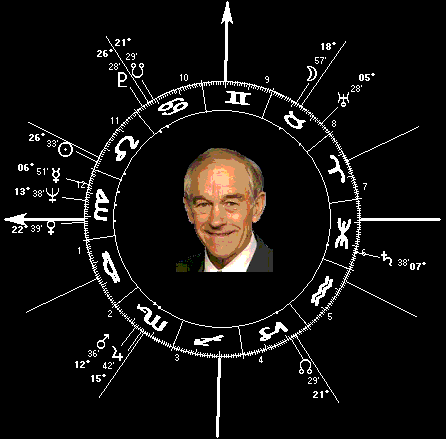 There's only one candidate who is even talking about doing the kind of things that could turn the tide - reviving the gold standard, closing the Fed, adopting a non-interventionist foreign policy, ending the income tax, etc. That's Dr. Ron Paul, who hasn't a prayer of winning the Republican nomination, let alone the general election. Born August 20, 1935 under a Virgo-Pisces Mercury-Saturn opposition and a lunar opposition to Mars and Jupiter conjunct in Scorpio, Dr. Paul is admirable and arguably right - two qualities that virtually guarantee he won't be the next US President. Dr. Paul's birth time hasn't been published, as far as I can determine at this time. But his exact birth time wouldn't change the fact that, on Election Day, Saturn out in space will be aligned with Venus' position when Dr. Paul was born: pretty much an ultra-long shot, if not an outright losing proposition.
There's only one candidate who is even talking about doing the kind of things that could turn the tide - reviving the gold standard, closing the Fed, adopting a non-interventionist foreign policy, ending the income tax, etc. That's Dr. Ron Paul, who hasn't a prayer of winning the Republican nomination, let alone the general election. Born August 20, 1935 under a Virgo-Pisces Mercury-Saturn opposition and a lunar opposition to Mars and Jupiter conjunct in Scorpio, Dr. Paul is admirable and arguably right - two qualities that virtually guarantee he won't be the next US President. Dr. Paul's birth time hasn't been published, as far as I can determine at this time. But his exact birth time wouldn't change the fact that, on Election Day, Saturn out in space will be aligned with Venus' position when Dr. Paul was born: pretty much an ultra-long shot, if not an outright losing proposition.
Failing a miraculous Paul win of the Republican nod, and then the election, there remains only one equally long shot at turning things around: a third party candidate winning in November. (Dr. Paul has virtually - but not absolutely - ruled out a third-party run, although he did run as a Libertarian candidate for President twenty years ago.) With birth certificate (BC) data of 3:40 PM in Brighton, MA on St. Valentine's Day in 1942, New York Mayor Michael Bloomberg is frequently mentioned as a possible third party contender for the Presidency. He's a long shot, but with both Jupiter and Saturn transiting to the trine point (120° angle) of his natal Mars (ruler of his tenth house of public standing), don't dismiss him out of hand.
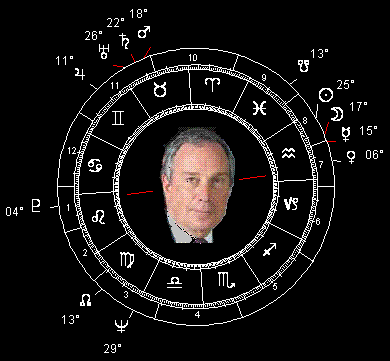 Absent a real choice, there are the leading contenders for the major party nominations, who as I write this are stumbling through the Presidential primary campaign. There are several real prospects on the Democratic side, including Senators Hillary Clinton, John Edwards and Barack Obama. Astrologically evaluating them is especially difficult because Senator Clinton's birth data fall in the "DD" category; as in Dirty Data, to use the old Rodden system of classification. That's because there are two or more birth times on record for her, with no authoritative documentation (e.g. a birth certificate) to resolve the differences. The Senator herself has been quoted for 8 AM and 8 PM (give or take a few minutes). Ah, the astrologer's dilemma, the voter's curse: politicians tell you one thing one time, and the very opposite another time . . . At least we know the rest of the data: October 26, 1947 in Chicago, IL (although there's minor disagreement on the place).
Absent a real choice, there are the leading contenders for the major party nominations, who as I write this are stumbling through the Presidential primary campaign. There are several real prospects on the Democratic side, including Senators Hillary Clinton, John Edwards and Barack Obama. Astrologically evaluating them is especially difficult because Senator Clinton's birth data fall in the "DD" category; as in Dirty Data, to use the old Rodden system of classification. That's because there are two or more birth times on record for her, with no authoritative documentation (e.g. a birth certificate) to resolve the differences. The Senator herself has been quoted for 8 AM and 8 PM (give or take a few minutes). Ah, the astrologer's dilemma, the voter's curse: politicians tell you one thing one time, and the very opposite another time . . . At least we know the rest of the data: October 26, 1947 in Chicago, IL (although there's minor disagreement on the place).
Senator Edwards' BC data (7:02 AM on June 10, 1953 in Seneca, SC) makes him the only "first tier" candidate for either party's nomination who has a publicly documented astrological chart. As for Senator Obama, all I can find from published sources is that he was born on August 4, 1961 in Honolulu, HI. And then there's dark horse former VP Al Gore, whose birth certificate shows 12:53 PM on March 31, 1948 in Washington, DC. Vice President Gore and Senator Edwards both have decent Jupiter aspects on Election Day, and they were both born under a Moon-Jupiter conjunction - the same alignment that will be seen in the sky after sunset on Election Eve. That gives them a leg up on Senator Clinton, whose uncertain birth time leaves room for doubt on lots of things - but not the Neptune transit opposing her natal Saturn. Barack Obama is clearly a man of destiny, having been born under a Great Chronocrator (Jupiter-Saturn conjunction) - in fact, under the last of the continuous earth sign series that defines modern civilization. (The exact conjunction occurred a few months before Obama was born, but Jupiter and Saturn were still only about five degrees apart at his birth. And, perhaps significantly, Jupiter had by then moved to the degree where the 2020 Chronocrator will take place.)
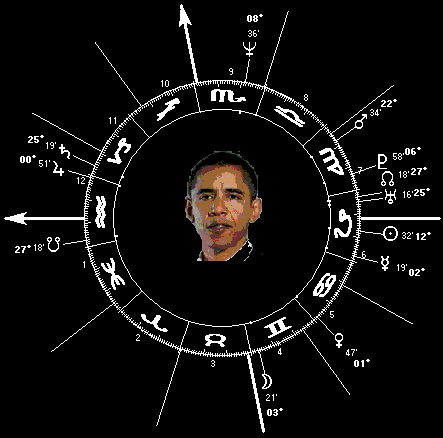 Republican contenders other than Dr. Paul include Mayor Rudy Giuliani, Governors Dale Huckabee and Mitt Romney, and Senator John McCain. Mayor Giuliani was born in Brooklyn on May 28, 1944, at 2:30 PM (time reportedly from his mother, according to an anonymous source). Governor Huckabee's birth time is unavailable, but every biographical reference I've seen agrees that he was born on August 24, 1955 in Hope, AR. Governor Romney was born on March 12, 1947 in Detroit, MI at 9:51 AM (time from him to astrologer Frances McEvoy). And then there's Senator McCain, born August 29, 1936 at Coco Solo in what was then the Panama Canal Zone, at about 9 AM to the best of his and his mother's recollection.
Republican contenders other than Dr. Paul include Mayor Rudy Giuliani, Governors Dale Huckabee and Mitt Romney, and Senator John McCain. Mayor Giuliani was born in Brooklyn on May 28, 1944, at 2:30 PM (time reportedly from his mother, according to an anonymous source). Governor Huckabee's birth time is unavailable, but every biographical reference I've seen agrees that he was born on August 24, 1955 in Hope, AR. Governor Romney was born on March 12, 1947 in Detroit, MI at 9:51 AM (time from him to astrologer Frances McEvoy). And then there's Senator McCain, born August 29, 1936 at Coco Solo in what was then the Panama Canal Zone, at about 9 AM to the best of his and his mother's recollection.
Like Democrat Senator Edwards and former Vice President Gore, Governor Romney was born under the same Moon-Jupiter alignment that graces the western horizon after sunset on Election Eve. But Saturn at polling time is transiting to oppose the Sun in Romney's natal chart, so I doubt he'll be giving a Pennsylvania Avenue address to the movers. Mayor Giuliani was also born under a Moon-Jupiter conjunction, but it's opposed by transiting Neptune at election time, even as transiting Saturn opposes his natal Saturn: not a favorable indicator in any number of ways. Governor Huckabee's unknown birth time leaves plenty of room for doubt, but what it does reveal isn't wildly favorable for his chances in the election. Senator McCain might just pass muster with the voters, in a "better the devil you know" kind of calculation: there are worse charts than his at election time.
With so many unknowns in terms of the candidates' birth data, it's going to be very difficult to repeat my success in calling past Presidential elections. The last two times, there were good data to work with and fewer prospects to evaluate. For 2008, there's far more uncertainty in the data, and no certainty at all as to who the candidates will be in the first place. (I'm writing this before the first caucus, let alone the first primary.) Lacking adequate data this time around, I see no alternative but to fall back on my planetary party theory; namely that Jupiter is associated with the Republicans, and Saturn with the Democrats.
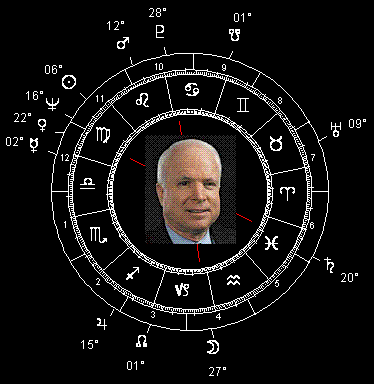 I know, I know, lots of people believe it's just the reverse; mainly on the theory that the GOP is the party of the conservatives and therefore falls under the dominion of Saturn, while the Democrats are the party of the liberals and therefore align with Jupiter. I say the Democrats are the party of fear and pessimism, the party that proclaims itself the protector of the common people - who need protection from the wealthy and powerful, of course. If that's not Saturn, nothing is. The Republicans on the other hand are the party of hope and optimism, the party that freed the slaves and opposes big government because it takes freedom and power from individuals. What else is that, if not Jupiter? Each party claims a beast of burden as its totem: the Democrats a donkey, the Republicans an elephant. If Jupiter doesn't fit an elephant better than a donkey, and vice versa for Saturn, then nothing makes sense in this world.
I know, I know, lots of people believe it's just the reverse; mainly on the theory that the GOP is the party of the conservatives and therefore falls under the dominion of Saturn, while the Democrats are the party of the liberals and therefore align with Jupiter. I say the Democrats are the party of fear and pessimism, the party that proclaims itself the protector of the common people - who need protection from the wealthy and powerful, of course. If that's not Saturn, nothing is. The Republicans on the other hand are the party of hope and optimism, the party that freed the slaves and opposes big government because it takes freedom and power from individuals. What else is that, if not Jupiter? Each party claims a beast of burden as its totem: the Democrats a donkey, the Republicans an elephant. If Jupiter doesn't fit an elephant better than a donkey, and vice versa for Saturn, then nothing makes sense in this world.
As a registered Libertarian, I have no dog in this fight. Frankly, I think both the major parties lack any real agenda today, other than to gain and hold power. But I look back on their history, and I can't help thinking that, in their origins, the Republicans and Democrats are described by Jupiter and Saturn respectively. Take the Republican Party's foundation, on February 28, 1854: a stellium (alignment) with the Sun, Moon and three planets in Pisces, one of the two signs ruled by Jupiter in ancient astrology. Contrast this with the founding of the Democratic Party on May 21, 1832: the sign with the highest count (the Moon plus Uranus along with the Moon's south node) is Aquarius - one of the two signs ruled by Saturn in ancient astrology. If you don't buy this reasoning, look at the history of US elections.
The 2008 election has been compared to those of 1928 and 1952, two years in which there was no sitting Vice President who assumed the mantle of leadership for the party in power. Both those elections featured a Sun-Jupiter opposition, which favors the GOP. In both cases, the GOP candidate emerged victorious: Herbert Hoover in '28, Dwight Eisenhower in '52. The election of 2000 featured a Jupiter-Pluto opposition, with Saturn not in any major alignment; again, an edge to the GOP, whose candidate (George Bush) won by one vote. Likewise 2004, held under the auspices of a Venus-Jupiter conjunction. Jupiter is out of alignment as the election is held this year, its fleeting conjunction with the Moon the night before being broken by the time voting starts. That leaves the year's signature aspect, the Saturn-Uranus opposition, as the dominant celestial feature of the 2008 election. And there's no way to read that as a Republican winning the election, as far as I can see: a Democrat, most likely, or maybe a third party or even bipartisan surprise, that's where the US gets its next President. As to who it will be in particular, I really don't have enough information to be sure this time: no candidate for certain, and no published birth time for two of the three top Democratic contenders. I figure a Democrat is more likely than a third party is more likely than a Republican, in that order. The strongest (or least disadvantaged) potential candidates, judging from less than sufficient data, look like John Edwards, Barack Obama, John McCain and Michael Bloomberg (in no particular order). But that's the best I can do with the incomplete data I have on hand. Just remember 1928, and what followed: 2008 will be déjà vu all over again, in many respects.
In summary, some years are marked by levity, others by gravity: 2008 definitely falls in the latter category. It's a global economic leveling-off on the whole, if not an outright downturn, as the world's nations and central banks attempt to come to grips with their counterfeit currency. There was a time in the Old South of US history when Confederate paper money actually bought things, and there followed an epoch when it was good only for kindling fires. We're on the cusp between two such epochs now, with respect to all the world's major currencies. A new world order is being built in this time of Trigonalis (1980-2020), and a new monetary system is part of its foundation. Per my forecasts for the past couple years, we've seen the collapse of the old global financial structure looming larger and larger under the aegis the 2006-2007 Saturn-Neptune opposition. It gets rockier this year, and then in the fall a new plan begins to be formulated under the Saturn-Uranus opposition that begins this year and continues on-and-off until 2010. I don't think it's all settled and done with by then, because I see other major celestial signposts on the way to 2020. But it's clear the big shake-out has begun, and the first real plan that leads to a new solution begins to emerge late this year. While not exactly a cause for levity, I think that's something to look forward to with some hopeful anticipation. In the meantime, find happiness in small things, because most of the big ones look rather messy.
ACKNOWLEDGMENTS: All astrological charts as well as eclipse and astro-locality maps were calculated and produced using Matrix Software's WinStar Plus 2.05. Additional astronomical diagrams and calculations were produced with John Walker's HomePlanet 3.1 and Maris Technologies' RedShift 5 software. Fred Espenak's NASA Eclipse Home Page is an indispensable online reference. Thanks to Alan Brown for many hours of discussion on historical details mentioned in this forecast.